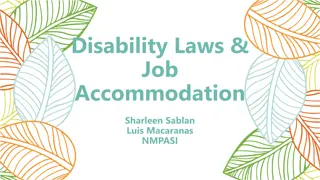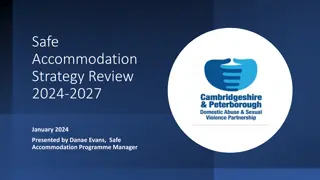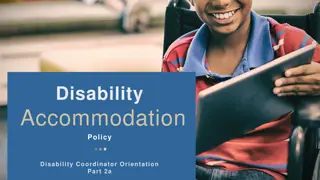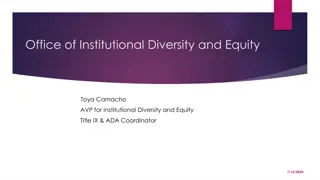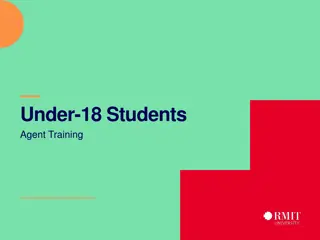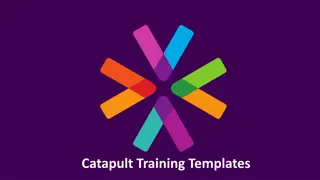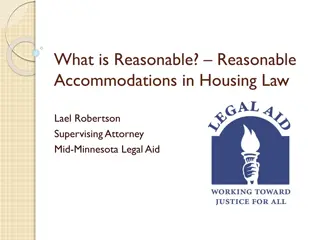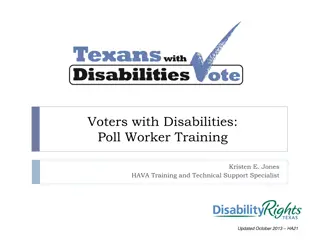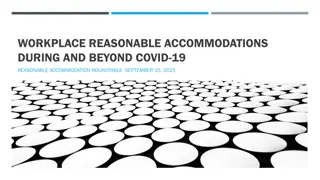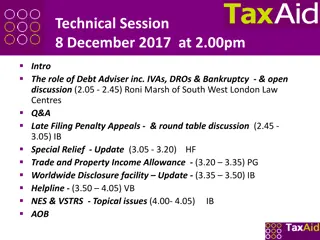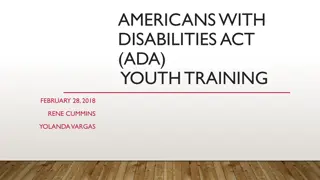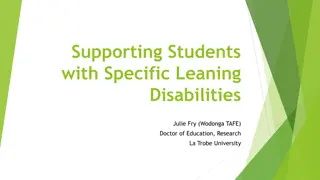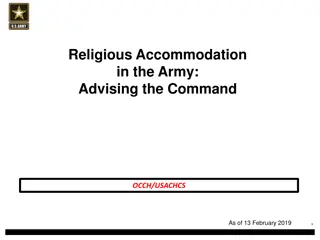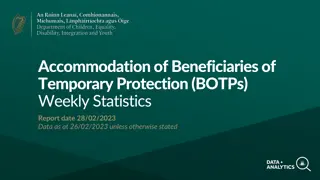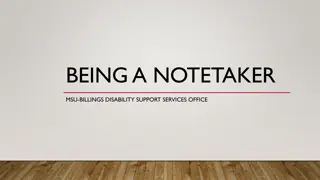Understanding Reasonable Accommodation for Students with Disabilities
Overview of the duty to accommodate under The Human Rights Code, including what it means, how it is triggered, examples of accommodations, and the limits to accommodation. Topics covered include disability-related special needs, protected characteristics, examples of accommodations, and the process for triggering accommodation. Accommodation is crucial in leveling the playing field for individuals with disabilities or other protected characteristics.
Download Presentation

Please find below an Image/Link to download the presentation.
The content on the website is provided AS IS for your information and personal use only. It may not be sold, licensed, or shared on other websites without obtaining consent from the author. Download presentation by click this link. If you encounter any issues during the download, it is possible that the publisher has removed the file from their server.
E N D
Presentation Transcript
REASONABLE ACCOMMODATION FOR STUDENTS WITH DISABILITIES HUMAN RIGHTS AND DIVERSITY OFFICE Stacey Belding, B.A. (Hon.), LL.B. HRDO
AGENDA Introduction Overview of duty to accommodate (what it means, how it is triggered, reasonable accommodation, examples, limits) Accommodation process at UW Statistics related to disability in Canada Learning disabilities types, potential impacts Accommodating learning (and other) disabilities in the classroom Questions
What is the Duty to Accommodate? Under The Human Rights Code, unreasonable discrimination in services is prohibited Discrimination includes failing to make reasonable accommodation for the special needs of an individual or group if those needs are based on a protected characteristic The duty to accommodate is the obligation to take special measures to remove barriers for someone who has a special need based on a disability or another protected characteristic Accommodation is meant to help level the playing field Protected characteristics include those listed in the Code. For accommodation purposes, usually disability related special needs. Accommodation may also need to be provided for religious beliefs/creed, pregnancy (sex), family status, gender identity, and other characteristics For full list of protected characteristics, see Section 9 of The Human Rights Code
What is the duty to accommodate? (cont.) Disability related accommodation examples include adaptive software (screen reader, speech to text, etc), accessible washroom, extra time to write an exam, note taker for class, extensions for assignments, additional breaks, allowing someone to eat in class, etc. Non-disability related examples include allowing someone time off to observe religious holiday or for religious practices, time off for medical appointments related to pregnancy, rescheduling exam due to child care issues, using someone s correct gender affirming name and pronouns in class and in any communications o Ideally process or service itself is not discriminatory not scheduling events or exams on religious holidays, universal instruction and design, wider aisles and other physical accessibility, materials presented in different formats and with captioning, etc. Accommodation must be provided to the point of undue hardship. Some hardship on the institution is considered ok. Reasonable accommodation requires an adequate process, as well as substantive accommodation. Need not be preferred accommodation.
How is the duty triggered? Usually the student seeking accommodation must identify the need for accommodation, which puts onus on service provider to engage in process o If requested, student must generally provide reasonable evidence substantiating or clarifying the need and cooperate in process (answering questions about limitations and prognosis, acceptable accommodations, etc.). Where student s need is disability-related, generally handled by Accessibility Services. If a service provider knows the person may need an accommodation, they have a duty to inquire even if not requested. Most often arises in cases of mental health or addictions, due to stigma or denial, or the person is unaware that they can seek accommodation. In some cases, it may be found that the service provider ought to have known . When ought the service provider to know (and thus inquire)? Very poor performance (esp. where uncharacteristic), behaving in a very unusual or uncharacteristic manner, awareness of certain circumstances (recent return from medical leave, seeing a psychologist, etc.). Mainly arises in employment context.
What is the test for reasonable accommodation? 1. Procedure employed to assess the issue of accommodation. In particular, what steps were taken to search for and consider options for accommodation. 2. The substance of the accommodation offered to an individual. Some examples of reasonable accommodation of disability are (these examples are not exhaustive): a. making buildings, facilities, workstations and services accessible to persons with physical disabilities through, for example, structural changes, or the provision of and modification to equipment and other devices; b. making employment and services available to persons with disabilities by altering existing practices or procedures, or adopting new practices or procedures;
What is the test for reasonable accommodation? 3. The duty to reasonably accommodate does not extend so far as to cause undue hardship to the person responsible for the activity or undertaking at issue. The burden of proving that undue hardship renders the accommodation unreasonable rests with the Respondent (service provider). To meet that burden, the Respondent must provide actual evidence that undue hardship exists rather than relying on anecdotal or impressionistic assumptions.
What is undue hardship? Generally, undue hardship is based on cost or health and safety. Not employee morale, or inconvenience. The vast majority of accommodations are not expensive nor are they unsafe or difficult to implement. Objective evidence is required (financial statements, invoices, etc) Cost is considered at institutional/business level, not unit (i.e.: if accommodation budget exceeded, look elsewhere) Consider outside sources of funding (both Respondent and Complainant), such as government assistance/programs, non-profit funders, etc Health and safety risks - consider: The nature of the risk: what could happen that would be harmful? The severity of the risk: how serious would the harm be if it occurred? The probability of the risk: how likely is it that the potential harm will actually occur? Is it a real risk, or merely hypothetical or speculative? Could it occur often? The scope of the risk: who will be affected if it occurs?
Undue hardship and limits to accommodation Issues of safety risks have been decided in various ways, in general risk on the individual is more tolerated than risk to others, i.e.: drug addiction in safety sensitive workplace vs risk to self Bona fide academic requirements can be established in advance Conflicting rights such as discrimination against others or significant interference with the rights of others will generally constitute undue hardship. But, would have a duty to accommodate everyone s special needs if they are based on protected characteristics. No hierarchy of rights. Person seeking accommodation must cooperate in the process, such as providing information to substantiate or clarify their need or restriction, making suggestions, and trying out options. Cannot reject solutions that are reasonable but not perfect.
Accommodation process at UW Duty to accommodate is acknowledged in Respectful Working and Learning Environment Policy (RWLE), Accessibility Plan, accommodation policies/procedures Students Accessibility Services for disability-related accommodations. Forms to complete along with providing medical evidence of special need. AS will notify the prof regarding the accommodations needed. If concern about whether reasonable accommodation is being provided, or what it should entail, any party can seek advice from HRDO While there are certain commonly used accommodations, it is always an individualized process
Disability in Canada An Overview An estimated one in five Canadians aged 15 years and over had one or more disabilities that limited them in their daily activities, according to new findings from the 2017 Canadian Survey on Disability (CSD). 13% of youths aged 15 to 24 years had one or more disabilities, with mental health-related disabilities being the most prevalent type of disability for this age group (60%) 20% of working age adults (25 to 64 years) have a disability 38% of seniors aged 65 and over have a disability Women (24%) are more likely to have a disability than men (20%), across all age groups Many disabilities are invisible - mental health, learning disabilities (10% of Canadians), etc. Almost half of all complaints to the Manitoba Human Rights Commission are disability-related (MHRC 2017 Annual Report) Disability is the most common ground involved in reasonable accommodation complaints across Canada. (Library of Parliament, An Examination of the Duty to Accommodate in the Canadian Human Rights Context) Under human rights law, focus is on obstacles to full participation in society rather than on the condition or state of an individual. Disability may be variable, and may or may not impact all aspects of one s life.
Learning Disabilities An Overview What is a Learning Disability? According to the Learning Disabilities Association of Canada, learning disabilities refer to a number of disorders which may affect the acquisition, organization, retention, understanding, or use of verbal or nonverbal information. These disorders affect learning in individuals who otherwise demonstrate at least average abilities essential for thinking and/or reasoning. As such, learning disabilities are distinct from global intellectual deficiency. While you likely won t know that someone has a learning disability unless you re told, you may notice that the person is experiencing difficulty with communication. Learning disabilities may present as weakness in listening, writing, speaking, reading, reasoning, mathematics, social skills, and memory. Many people with learning disabilities are reluctant to disclose due to stigma.
Learning Disabilities An Overview Types of Learning Disabilities Dyscalculia affects a person s ability to understand numbers and learn math facts Dysgraphia affects a person s handwriting ability and fine motor skills Dyslexia affects reading and related language-based processing skills Dyspraxia affects the development of motor skills ADHD causes people to lose focus on tasks very easily Non-verbal Learning Disorders may cause difficulty understanding facial expression and body language, may include poor co-ordination, balance problems and difficulty with fine motor skills Auditory Processing Disorders may cause a person to struggle with distinguishing similar sounds, as well as other difficulties Visual Processing Disorders maycause people to struggle with seeing the differences between similar letters, number, objects, colors, shapes and patterns Adapted from the Learning Disabilities Association of America, The Learning Disabilities Association of PEI
Accommodating Learning (and other) Disabilities in the Classroom Important point to remember: Avoid making assumptions about a person s disability or capabilities; while there are generally accepted or common characteristics and accommodations, everyone is different These suggestions may also assist students with other disabilities, and are general best practices Prior to the start of the course Choose course materials early to allow sufficient time to convert the documents into alternative formats, or for students to request the formats they need. If possible, provide accessible electronic versions of course readings. This will enable students to convert the reading into the format required, whether they use a screen reader, an enlarger or another technology. Be as precise as you can regarding the texts and pages that will be used. If possible, provide advance course notes, copies of overhead slides, PowerPoint presentations and other materials. Tips adapted from https://accessiblecampus.ca/tools-resources/educators-tool-kit/teaching-tips/teaching- students-with-learning-disabilities/
Accommodating Learning (and other) Disabilities in the Classroom When the course begins Encourage students to attend AS regarding any accessibility concerns. You can do this verbally early in the semester and/or by including an accessibility statement on your syllabus. Indicate that such conversations are confidential and are strictly for facilitating any learning needs or accommodations, and that a diagnosis is not required (only functional limitations). o If a student talks to you directly, keep it confidential and do not ask for a diagnosis Identify and clearly express the essential course content, and recognize that students can express understanding of essential course content in multiple ways. Diversify assignments or allow for exceptions to enable all students to demonstrate their specific talents (for example, oral presentations, written assignments, etc).
Accommodating Learning (and other) Disabilities in the Classroom When the course begins Insist on professional, civil conduct between and among students to respect people s differences and create an inclusive environment. Can point to RWLE. It can be helpful to say at the beginning of classes that all students learn differently, so as to encourage respect for different learning styles. Provide your classes with information about the accessible features of their immediate environment (for example, automatic doors and accessible washrooms). Provide an organized, well-written and complete syllabus including required readings, assignments, due dates and defined expectations as early as possible. Students can miss verbal instructions for various reasons. Ask for volunteer note takers as needed.
Accommodating Learning (and other) Disabilities in the Classroom While in session Put the lecture in context. Give students the big picture of where it fits into the overall course and how it relates to earlier materials. Consider beginning each class with a review of earlier material. Summarize important points at the end of class, by using a PowerPoint slide, board, overhead projector, etc. Provide both verbal and written instructions with reminders of impending due dates for assignments or exams. Be patient sometimes communicating with someone with a disability can take a bit longer, requiring you or the other person to repeat comments several times. Allow scheduled breaks during lectures, tests and exams. Include captioning (or capability) in online lectures or videos
Accommodating Learning (and other) Disabilities in the Classroom While in session (cont.) Point out the important sections in course plans, textbooks and readings to guide test and exam preparation; when possible, provide samples of tests and exams Allow for the use of adaptive technology Allow students to audio-record lectures, or record Zoom/online course Allow for preferential seating, either to facilitate better listening or to allow for proximity to an electrical outlet Arrange to meet with the student to discuss specific learning needs, strategies for success, alternatives to course assignments, and methods of evaluation when the student provides his or her letter of accommodation Provide personal feedback on academic performance in a respectful way (do not criticize or blame) Faculty is allowed to manage class room behaviour and set expectations. In the event a student or a service animal is being disruptive, you can reach out to AS for advice.
Accommodating Learning (and other) Disabilities in the Classroom Tests, exams and evaluation When possible, allow the use of a calculator, dictionary, computer and word processor with spell-check, as needed. When possible, allow the use of memory aids for formulas or definitions. Offer alternatives to traditional course work and methods of evaluation (such as an oral exam or presentation instead of a written exam, or an essay instead of multiple-choice and short-answer questions). Allow extra time on tests and/or exams (generally via AS) Provide a separate, distraction-free room for writing tests and/or exams (may be via AS) Allow for the use of adaptive technology (for example, screen-readers or screen-enhancement software such as screen magnification) (generally via AS)
Tips for Approaching Students If you suspect a student is struggling or they are disruptive in class due to disability you can ask to speak with them privately o Ensure you approach the student respectfully and maintain confidentiality if they disclose anything o Ask them how things are going, tell them you support them and would like to ensure they get any assistance they need. You can simply ask, can I help/how can I help? o Speak normally, clearly and directly. Be patient if they take a bit longer to understand and respond. o Listen carefully to their suggestions and work with them to provide information in a way that will best suit their needs. Do not ask for a diagnosis or any details about their medical condition o Legally we are not entitled to diagnosis, only functional limitations/needs Remember your role is not to determine their medical related special needs refer them to Accessibility Services, especially if you are unable to accommodate them with the course delivery method or they require aids or supports Never blame the student for their disability-related symptoms or behaviours. Do not assume the student can control their symptoms. Do not blame or penalize the student for not attending AS sooner. People may self-accommodate, don t realize they need or can access support, or their medical condition is new or variable
QUESTIONS? Stacey Belding, B.A. (Hon.), LL.B. HRDO s.belding@uwinnipeg.ca (204) 988-7508



